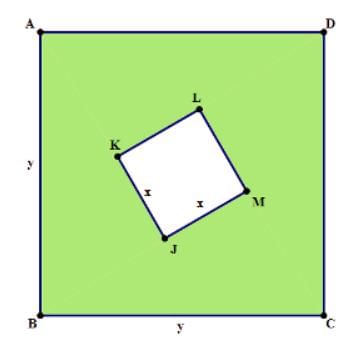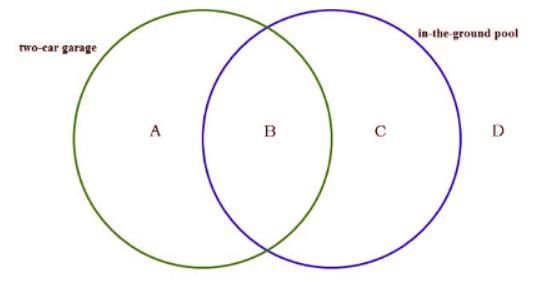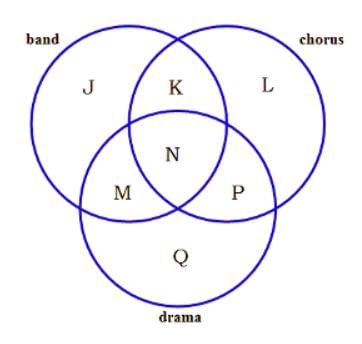GMAT Focus Edition Mock test - 3 - GMAT MCQ
30 Questions MCQ Test - GMAT Focus Edition Mock test - 3
The original price of a suit is $200. The price increased 30%, and after this increase, the store published a 30% off coupon for a one-day sale. Given that the consumers who used the coupon on sale day were getting 30% off the increased price, how much did these consumers pay for the suit?
Of the 80 houses in a development, 50 have a two-car garage, 40 have an in-the-ground swimming pool, and 35 have both a two-car garage and an in-the-ground swimming pool. How many houses in the development have neither a two-car garage nor an in-the-ground swimming pool?

ABCD is a square with a side y, and JKLM is a square with side x. If Rectangle S (not shown) with length x + y has the same area as the shaded region above, what is the width of Rectangle S?

ABCD is a square with a side y, and JKLM is a square with side x. If Rectangle S (not shown) with length x + y has the same area as the shaded region above, what is the width of Rectangle S?
Consider a set S = {2, 4, 6, 8, x, y} with distinct elements. If x and y are both prime numbers and 0 < x < 40 and 0 < y < 40, which of the following MUST be true?
I. The maximum possible range of the set is greater than 33.
II. The median can never be an even number.
III. If y = 37, the average of the set will be greater than the median.
There are two sets of letters, and you are going to pick exactly one letter from each set.
Set #1 = {A, B, C, D, E}
Set #2 = {K, L, M, N, O, P}
What is the probability of picking a C and an M?
If x and y are integers and |x - y| = 12, what is the minimum possible value of xy?
If the ratio of the sum of the first 6 terms of a G.P. to the sum of the first 3 terms of the G.P. is 9, what is the common ratio of the G.P?
A car drives 300 miles at 30 mph, and then 300 miles at 60 miles per hour. What is the car’s average speed, in mph?

The dark purple region on the number line above is shown in its entirety. This region is delineated by which of the following inequalities?
The profits of QRS company rose 10% from March to April, then dropped 20% from April to May, then rose 50% from May to June. What was the percent increase for the whole quarter, from March to June?
A certain school has three performing arts extracurricular activities: Band, Chorus, or Drama. Students must participate in at least one, and may participate in two or even in all three. There are 120 students in the school. There are 70 students in Band, 73 in the Chorus, and 45 in the Drama. Furthermore, 37 students are in both the Band and Chorus, 20 are in both the Band and the Drama, and 8 students are in all three groups. Twenty-five students are just in the chorus, not in anything else. How many students participate in only the drama?

What is the largest integral value of m such that the quadratic equation x2 – 10x + m will have two unique solutions?
Three positive integers a, b, and c are such that their average is 20 and a ≤ b ≤ c. If the median is (a + 11), what is the least possible value of c?
There are two sets of letters, and you are going to pick exactly one letter from each set.
Set #1 = {A, B, C, D, E}
Set #2 = {K, L, M, N, O, P}
What is the probability of picking a C or an M?
How many four-digit positive integers exist that contain the block 25 and are divisible by 75. (2250 and 2025 are two such numbers)?
A car drives for 3 hours at 40 mph and then drives 300 miles at 60 mph. What is the car’s average speed, in mph?

If |x| < 20 and |x – 8| > |x + 4|, which of the following expresses the allowable range for x?
In a certain game, you pick a card from a standard deck of 52 cards. If the card is a heart, you win. If the card is not a heart, the person replaces the card to the deck, reshuffles, and draws again. The person keeps repeating that process until he picks a heart, and the point is to measure: how many draws did it take before the person picked a heart and won? What is the probability that one will have at least three draws before one picks a heart?
Bert and Rebecca were looking at the price of a condominium. The price of the condominium was 80% more than Bert had in savings, and separately, the same price was also 20% more than Rebecca had in savings. What is the ratio of what Bert has in savings to what Rebecca has in savings.
There are two sets of letters, and you are going to pick exactly one letter from each set.
Set #1 = {A, B, C, D, E}
Set #2 = {K, L, M, N, O, P}
There are these two sets of letters, and you are going to pick exactly one letter from each set. What is the probability of picking at least one vowel?
Susan invited 13 of her friends for her birthday party and created return gift hampers comprising one each of $3, $4, and $5 gift certificates. One of her friends did not turn up and Susan decided to rework her gift hampers such that each of the 12 friends who turned up got $13 worth gift certificates. How many gift hampers did not contain $5 gift certificates in the new configuration?
Students from outside the province of Merryweather, who in any given academic year pay twice as much tuition each as do students from within Merryweather, had traditionally accounted for at least two-thirds of the enrollment at Central Merryweather College. Over the past 10 years academic standards at the college have risen, and the proportion of students who are not from Merryweather has dropped to around 40%.
Q. Which one of the following reasonably be inferred from the statements above?
According to an article in a nutritional magazine, eating beets significantly lowers the risk of cancer. The article refers to a study that found that people who consumed one or more beets per day were half as likely to be diagnosed with cancer as people who did not.
Q. Which of the following, if true, most weakens the argument in the magazine article?
Thousands of people contract tonsillitis every year, and yet all go on to live normal lives after the operation. We can conclude, from this observation, that the tonsils have no function in the body.
Q. The argument would be most weakened by which of the following, if it were true?
Two students were given practice exams. One exam ordered the questions from hardest to easiest, while the other exam ordered the questions from easiest to hardest. The student who took the test with questions ordered hardest to easiest performed more poorly than the other student. Therefore, tests that ordered hardest to easiest will cause a student to perform more poorly.
Q. This argument is most vulnerable to criticism if which of the following statements is true?
Passage
In the bustling world of technology, a recent exposé titled "Tech Titans and their Ties" has shed light on the intricate relationships between major Silicon Valley players and the startup ecosystem. The author, Jane Anderson, delves into the alliances, partnerships, and financial dealings that shape the landscape of innovation and entrepreneurship.
The exposé begins by highlighting the symbiotic nature of these relationships, emphasizing how established tech giants often invest in or acquire promising startups to stay at the forefront of innovation. Anderson contends that this synergy not only fuels technological advancements but also strategically positions the larger companies as key players in emerging markets.
However, the author doesn't shy away from the darker side of these collaborations. Anderson points out that some tech titans exploit their financial muscle to stifle competition, acquiring startups merely to eliminate potential rivals rather than fostering genuine innovation. The cutthroat tactics employed by these industry behemoths, she argues, can stifle creativity and limit the diversity of ideas in the tech ecosystem.
The exposé then takes a historical turn, drawing parallels between the current state of the tech industry and the corporate landscape of the early 20th century. Anderson suggests that just as monopolies were scrutinized and regulated in the past, there is a growing need for modern antitrust measures to curb the concentration of power within the tech sector. She argues that such regulations are essential to ensure a level playing field for startups and prevent the formation of digital monopolies that could stifle healthy competition.
Q. Which of the following would be the most appropriate title for the passage?
Passage
In the bustling world of technology, a recent exposé titled "Tech Titans and their Ties" has shed light on the intricate relationships between major Silicon Valley players and the startup ecosystem. The author, Jane Anderson, delves into the alliances, partnerships, and financial dealings that shape the landscape of innovation and entrepreneurship.
The exposé begins by highlighting the symbiotic nature of these relationships, emphasizing how established tech giants often invest in or acquire promising startups to stay at the forefront of innovation. Anderson contends that this synergy not only fuels technological advancements but also strategically positions the larger companies as key players in emerging markets.
However, the author doesn't shy away from the darker side of these collaborations. Anderson points out that some tech titans exploit their financial muscle to stifle competition, acquiring startups merely to eliminate potential rivals rather than fostering genuine innovation. The cutthroat tactics employed by these industry behemoths, she argues, can stifle creativity and limit the diversity of ideas in the tech ecosystem.
The exposé then takes a historical turn, drawing parallels between the current state of the tech industry and the corporate landscape of the early 20th century. Anderson suggests that just as monopolies were scrutinized and regulated in the past, there is a growing need for modern antitrust measures to curb the concentration of power within the tech sector. She argues that such regulations are essential to ensure a level playing field for startups and prevent the formation of digital monopolies that could stifle healthy competition.
Q. It can be inferred from the passage that the author, Jane Anderson, would be most likely to agree with which of the following statements regarding tech collaborations?
Passage
In the bustling world of technology, a recent exposé titled "Tech Titans and their Ties" has shed light on the intricate relationships between major Silicon Valley players and the startup ecosystem. The author, Jane Anderson, delves into the alliances, partnerships, and financial dealings that shape the landscape of innovation and entrepreneurship.
The exposé begins by highlighting the symbiotic nature of these relationships, emphasizing how established tech giants often invest in or acquire promising startups to stay at the forefront of innovation. Anderson contends that this synergy not only fuels technological advancements but also strategically positions the larger companies as key players in emerging markets.
However, the author doesn't shy away from the darker side of these collaborations. Anderson points out that some tech titans exploit their financial muscle to stifle competition, acquiring startups merely to eliminate potential rivals rather than fostering genuine innovation. The cutthroat tactics employed by these industry behemoths, she argues, can stifle creativity and limit the diversity of ideas in the tech ecosystem.
The exposé then takes a historical turn, drawing parallels between the current state of the tech industry and the corporate landscape of the early 20th century. Anderson suggests that just as monopolies were scrutinized and regulated in the past, there is a growing need for modern antitrust measures to curb the concentration of power within the tech sector. She argues that such regulations are essential to ensure a level playing field for startups and prevent the formation of digital monopolies that could stifle healthy competition.
Q. The passage supplies information for answering which of the following questions?
Eggplants are always purple. John bought a purple vegetable. Therefore, it was an eggplant.
Q. Which of the following arguments contains reasoning most similar to the flawed reasoning in the above argument?
Advertisement: Coma Cola is the best-tasting cola on the market and we conducted a test using over 1000 cola consumers to prove it. Each consumer was given two identical cups filled with a carbonated beverage from the same fountain. One cup was filled with Coma Cola and the other was filled with unadulterated soda water. Ninety-nine percent of the consumers preferred the Coma Cola. So, Coma Cola is the best tasting cola available.
Q. The advertisement’s reasoning is most vulnerable to criticism on the grounds that it fails to consider whether ___________________






















